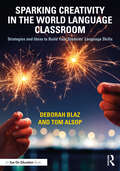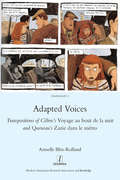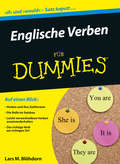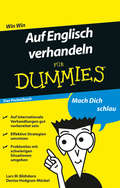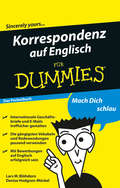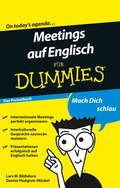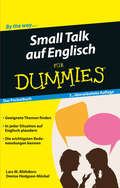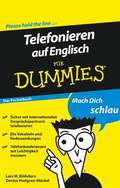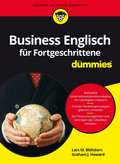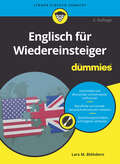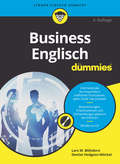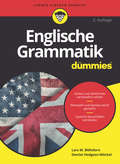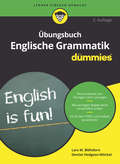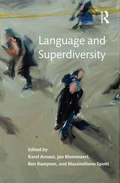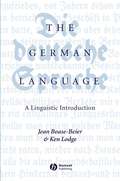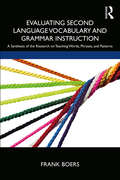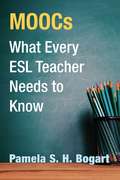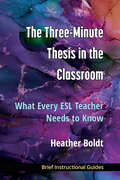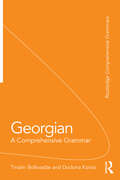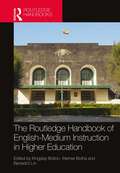- Table View
- List View
Sparking Creativity in the World Language Classroom: Strategies and Ideas to Build Your Students’ Language Skills
by Deborah Blaz Tom AlsopJam-packed with inspiring lessons and ideas, this book will help you access and enhance your own creativity in the classroom and inspire your students to become motivated language learners. Top authors Blaz and Alsop share practical strategies to channel your creative impulses and transform them into effective lessons that will energize students of all levels. Aligned with ACTFL (American Council on the Teaching of Foreign Languages) and CEFR (Common European Framework of Reference for Languages) standards, the resources in this book support creativity as a practical process, with step-by-step guidance on goal-setting, implementation, evaluation, and feedback. Examples come from many world languages and cover fun and original topics, including tapping into students’ own interests through cooking, memes, online videos, sports, arts and crafts, and more. Relevant for all levels of language instruction, this text includes plentiful photocopiable charts, templates, and samples to use in the classroom.
Sparking Creativity in the World Language Classroom: Strategies and Ideas to Build Your Students’ Language Skills
by Deborah Blaz Tom AlsopJam-packed with inspiring lessons and ideas, this book will help you access and enhance your own creativity in the classroom and inspire your students to become motivated language learners. Top authors Blaz and Alsop share practical strategies to channel your creative impulses and transform them into effective lessons that will energize students of all levels. Aligned with ACTFL (American Council on the Teaching of Foreign Languages) and CEFR (Common European Framework of Reference for Languages) standards, the resources in this book support creativity as a practical process, with step-by-step guidance on goal-setting, implementation, evaluation, and feedback. Examples come from many world languages and cover fun and original topics, including tapping into students’ own interests through cooking, memes, online videos, sports, arts and crafts, and more. Relevant for all levels of language instruction, this text includes plentiful photocopiable charts, templates, and samples to use in the classroom.
Adapted Voices
by Armelle Blin-RollandVoyage au bout de la nuit (1932), by Louis-Ferdinand Celine (1894-1961), and Zazie dans le metro (1959), by Raymond Queneau (1903-1976), were two revolutionary novels in their transposition of spoken language into written language. Since their publication they have been adapted into a broad range of media, including illustrated novel, bande dessinee, film, stage performance and recorded reading. What happens to their striking literary voices as they are transposed into media that combine text and image, sound and image, or consist of sound alone? In this study, Armelle Blin-Rolland examines adaptations sparked by these two seminal novels to understand what 'voice' means in each medium, and its importance in the process of adaptation.
Adapted Voices
by Armelle Blin-RollandVoyage au bout de la nuit (1932), by Louis-Ferdinand Celine (1894-1961), and Zazie dans le metro (1959), by Raymond Queneau (1903-1976), were two revolutionary novels in their transposition of spoken language into written language. Since their publication they have been adapted into a broad range of media, including illustrated novel, bande dessinee, film, stage performance and recorded reading. What happens to their striking literary voices as they are transposed into media that combine text and image, sound and image, or consist of sound alone? In this study, Armelle Blin-Rolland examines adaptations sparked by these two seminal novels to understand what 'voice' means in each medium, and its importance in the process of adaptation.
Englische Verben für Dummies (Für Dummies)
by Dr. Lars M. BlöhdornDie englischen Verben haben es in sich. Wann wird ein -s angehängt und wann ein -ed? Wie war das noch mal mit if und would? Und welche Unterschiede bei den Verben gibt es zwischen britischem und amerikanischem Englisch? Lars Blöhdorn macht es Ihnen leicht, dort einzusteigen, wo es für Sie die größten Stolpersteine gibt. Leicht verständlich und mit der üblichen Prise Humor erläutert er die Bildung von Zeiten, Konditionalsätzen, Passivformen und indirekter Rede. Und schon verlieren diese grammatischen Ungetüme ihren Schrecken. Sie erfahren, wie Sie zusammengesetzte Verben richtig verwenden, welche idiomatischen Ausdrücke Sie kennen sollten, wie neue Verben gebildet werden und was in der Alltagssprache wichtig ist. Dank der Übungen am Ende eines jeden Kapitels können Sie Ihre Lernfortschritte schnell überprüfen.
Auf Englisch verhandeln fur Dummies Das Pocketbuch (Für Dummies)
by Dr. Lars M. Blöhdorn Denise Hodgson-MöckelNicht jeder, der souverän und erfolreich eine Verhandlung führen kann, fühlt sich auch im Umgang mit englischsprachigen Verhandlungspartnern sicher. Lars M. Blöhdorn und Denise Hodgson-Möckel geben Ihnen die wichtigsten Vokabeln und Redewendungen für Verhandlungen auf Englisch an die Hand. Die Autoren verraten Ihnen auch, wie sie so manche Klippe bei schwierigen Verhandlungen umschiffen können. So können Sie gelassen und gut vorbereitet Ihrer nächsten Verhandlung auf Englisch entgegensehen.
Korrespondenz auf Englisch fur Dummies Das Pocketbuch (Für Dummies)
by Dr. Lars M. Blöhdorn Denise Hodgson-MöckelHaben Sie häufiger mit englischsprachigen Kunden oder Kollegen zu tun? Oder wollen sich auf Englisch bewerben? Lars M. Blöhdorn und Denise Hodgson-Möckel geben Ihnen die wichtigsten Wörter und Formulierungen an die Hand. Von der richtigen Anrede und dem korrekten Aufbau von Angeboten, Reklamationen oder Einladungen über E-Mail-Etikette bis zur englischsprachigen Bewerbung für Ihren Traumjob finden Sie hier alles Wichtige für eine freundliche und verständliche Korrespondenz auf Englisch.
Meetings auf Englisch für Dummies (Für Dummies)
by Dr. Lars M. Blöhdorn Denise Hodgson-MöckelSie wollen oder müssen Meetings mit internationalen Geschäftspartnern organisieren und fragen sich, wie das auf Englisch aussehen sollte? »Meetings auf Englisch für Dummies« hilft Ihnen, Besprechungen in englischer Sprache erfolgreich vorzubereiten und durchzuführen und dabei Kommunikationsklippen gekonnt zu umschiffen. Lars Blöhdorn und Denise Hodgson-Möckel bieten Ihnen viele hilfreiche Hinweise, praxisorientierte Beispiele und nützliche Hintergrundinformationen, damit Ihr Meeting zum Erfolg wird.
Small Talk auf Englisch für Dummies (Für Dummies)
by Dr. Lars M. Blöhdorn Denise Hodgson-MöckelSie kommunizieren in Ihrem Beruf mit Geschäftspartnern aus anderen Ländern? Sie reisen viel und wollen ein paar Sätze parat haben, um mit Menschen auf Englisch in Kontakt zu treten? Das Pocketbuch »Small Talk auf Englisch für Dummies« hilft Geschäftsleuten und Reisenden, Small Talk auf Englisch über verschiedene Themen zu betreiben und dabei Kommunikationsklippen gekonnt zu umschiffen. Lars M. Blöhdorn und Denise Hodgson-Möckel bieten Ihnen verständlich formulierte Hinweise, praxisorientierte Beispiele und nützliche Hintergrundinformationen - damit wird Small Talk auf Englisch zum Kinderspiel.
Telefonieren auf Englisch fur Dummies Das Pocketbuch (Für Dummies)
by Dr. Lars M. Blöhdorn Denise Hodgson-MöckelNach der Lektüres dieses Buches werden Sie entspannt zum Hörer greifen, wenn Sie wieder einmal geschäftlich auf Englisch telefonieren müssen. Sie erfahren, wie Sie sich vorstellen, wie Sie nachfragen, wie Sie Small Talk treiben und wie Sie sich verabschieden. Die Autoren geben Ihnen für alle möglichen Gesprächssituationen die wichtigsten Vokabeln an die Hand. Vereinbaren Sie Termine, nehmen Sie Nachrichten entgegen, sprechen Sie auf einen Anrufbeantworter, nehmen Sie an Telefonkonferenzen teil.
Business Englisch für Fortgeschrittene für Dummies (Für Dummies)
by Dr. Lars M. Blöhdorn Graham J. HowardEnglisch spielt im Berufsalltag vieler eine immer größere Rolle. Da genügt es oft nicht mehr, sicher auf Englisch telefonieren und korrespondieren zu können. Wenn Sie in der Corporate World sicher mit Englisch umgehen müssen, ist »Business Englisch für Fortgeschrittene für Dummies« das richtige Buch für Sie. Zunächst geht es um die Außendarstellung des Unternehmens und die internationale Unternehmenskommunikation. Es werden Vokabular, Satz- und Textbeispiele für den Handel auf dem Weltmarkt präsentiert und interkulturelle Aspekte betrachtet. Die Rolle des Englischen im internationalen Finanzmanagement nimmt einen weiteren wichtigen Teil ein. Hier geht es um Angebotsgestaltung und Rechnungslegung, Kreditbedingungen, Investmentvoraussetzungen, aber auch um Steuern, Dividenden sowie Buchhaltung und Geschäftsberichte. Die Autoren gehen auch auf rechtliche Aspekte im internationalen Umfeld ein. Sie behandeln Geschäftsbedingungen, Vertragsgestaltung, Konfliktmanagement in interkulturellen Settings, aber auch Fragen der Nachhaltigkeit und nicht zuletzt das Thema Mergers & Acquisitions. Viele Bespielformulierungen geben Ihnen Sicherheit, auch komplexere Sachverhalte zu verstehen und bei wirtschaftlichen Sachthemen mitreden zu können.
Englisch für Wiedereinsteiger für Dummies (Für Dummies)
by Lars M. BlöhdornMit diesem Buch gelingt Ihnen der Wiedereinstieg ins Englische. Nach einer kurzen Wiederholung der Grammatikregeln bereitet das Buch Sie bestens auf Gesprächssituationen aller Art vor: Gehen Sie mit Englisch auf Reisen, kommunizieren Sie souverän im Berufsalltag und telefonieren Sie stressfrei auf Englisch. Anschließend lernen Sie, wie Sie englische Texte treffend formulieren. So fällt es Ihnen leicht, private und berufliche Korrespondenz zu führen und mit internationalen Bewerbungen zu punkten. Zudem erfahren Sie, wie Sie Zeitungsartikel entschlüsseln, Werbesprüche richtig einordnen und die gesprochene Sprache besser verstehen. Im Anhang finden Sie die wichtigsten unregelmäßigen Verben, Zahlen und Maßeinheiten und ein kleines Wörterbuch Deutsch-Englisch, Englisch-Deutsch.
Business Englisch für Dummies (Für Dummies)
by Lars M. Blöhdorn Denise Hodgson-MöckelSie haben Kontakt zu internationalen Geschäftspartnern, doch wenn Sie mit ihnen auf Englisch kommunizieren, fehlen Ihnen die (richtigen) Worte? Damit sind Sie nicht allein. Auch wenn die Schulzeit bei manchen noch nicht allzu weit zurückliegt, fällt es vielen schwer, auf Englisch zu telefonieren, Geschäftsbriefe oder E-Mails zu schreiben, sich in Meetings oder Verhandlungen verständlich auszudrücken oder auch Small Talk zu führen. Mit »Business Englisch für Dummies« lernen Sie anhand praxisorientierter Beispiele, sich verständlich auszudrücken und auf der internationalen Bühne eine gute Figur zu machen.
Englische Grammatik für Dummies (Für Dummies)
by Lars M. Blöhdorn Denise Hodgson-MöckelSie wollen - oder müssen - Englisch sprechen und wollen auch verstanden werden? Sie möchten E-Mails auf Englisch verfassen oder bereiten sich gar auf den TOEFL vor? Dann ist dieses Buch genau das richtige für Sie: Lars Blöhdorn, Dozent der Sprachwissenschaften, und Denise Hodgson-Möckel, Dozentin und Muttersprachlerin, erklären Ihnen locker, witzig und leicht verständlich auch die kompliziertesten Regeln der englischen Sprache.
Übungsbuch Englische Grammatik für Dummies (Für Dummies)
by Lars M. Blöhdorn Denise Hodgson-MöckelLocker, witzig und leicht verständlich erklären Lars M. Blöhdorn und Denise Hodgson-Möckel auch die kompliziertesten Regeln der englischen Grammatik. Um sie zu behalten, hilft allerdings nur üben, üben, üben. Dazu gibt Ihnen dieses Buch mit Hunderten Übungen und deren Lösungen Gelegenheit. So geht Ihnen die englische Grammatik in Fleisch und Blut über und Sie können gelassen der nächsten Klausur, dem TOEFL oder dem GMAT entgegensehen.
Language and Superdiversity
by Jan Blommaert Karel Arnaut Massimiliano Spotti Ben RamptonA first synthesis of work done in sociolinguistic superdiversity, this volume offers a substantial introduction to the field and the issues and state-of-the-art research papers organized around three themes: Sketching the paradigm, Sociolinguistic complexity, Policing complexity. The focus is to show how complexity rather than plurality can serve as a lens through which an equally vast range of topics, sites, and issues can be tied together. Superdiversity captures the acceleration and intensification of processes of social ‘mixing’ and ‘fragmentation’ since the early 1990s, as an outcome of two different but related processes: new post-Cold War migration flows, and the advent and spread of the Internet and mobile technologies. The confluence of these forces have created entirely new sociolinguistic environments, leading to research in the past decade that has brought a mixture of new empirical terrain–extreme diversity in language and literacy resources, complex repertoires and practices of participants in interaction–and conceptual challenges. Language and Superdiversity is a landmark volume bringing together the work of the scholars and researchers who spearhead the development of the sociolinguistics of superdiversity.
Language and Superdiversity: Recombining Spaces, Times And Language Practices (Encounters Ser. #7)
by Jan Blommaert Karel Arnaut Massimiliano Spotti Ben RamptonA first synthesis of work done in sociolinguistic superdiversity, this volume offers a substantial introduction to the field and the issues and state-of-the-art research papers organized around three themes: Sketching the paradigm, Sociolinguistic complexity, Policing complexity. The focus is to show how complexity rather than plurality can serve as a lens through which an equally vast range of topics, sites, and issues can be tied together. Superdiversity captures the acceleration and intensification of processes of social ‘mixing’ and ‘fragmentation’ since the early 1990s, as an outcome of two different but related processes: new post-Cold War migration flows, and the advent and spread of the Internet and mobile technologies. The confluence of these forces have created entirely new sociolinguistic environments, leading to research in the past decade that has brought a mixture of new empirical terrain–extreme diversity in language and literacy resources, complex repertoires and practices of participants in interaction–and conceptual challenges. Language and Superdiversity is a landmark volume bringing together the work of the scholars and researchers who spearhead the development of the sociolinguistics of superdiversity.
The German Language: A Linguistic Introduction
by Jean Boase-Beier Ken R. LodgeThe German Language introduces students of German to a linguistic way of looking at the language. Written from a Chomksyan perspective, this volume covers the basic structural components of the German language: syntax, morphology, phonetics, phonology, and the lexicon. Explores the linguistic structure of German from current theoretical perspectives. Written from a Chomksyan perspective, this volume covers the basic structural components of the German language: syntax, morphology, phonetics, phonology, and the lexicon. Serves as a valuable resource for students of German language and literature and for linguists with little or no background in the language. Includes exercises, definitions of key terms, and suggestions for further reading.
Evaluating Second Language Vocabulary and Grammar Instruction: A Synthesis of the Research on Teaching Words, Phrases, and Patterns
by Frank BoersProviding a much-needed critical synthesis of research on teaching vocabulary and grammar to students of a second or foreign language, this book puts the research into perspective in order to distil recommendations for language teaching. Boers evaluates a comprehensive range of both well-established and lesser-known research strands and classroom practices to draw out the most effective instructional approaches to teaching words, multiword expressions and grammar patterns. Chapters discuss learning as a by-product of communicative activities, language-focused instruction, diverse types of exercises, mnemonic techniques and more, with a view to building bridges between the available research on such instructional approaches and how they are commonly implemented in actual language courses and textbooks. This book helps teachers make research-informed decisions regarding their instructional approaches to words, phrases and patterns, and direct researchers to specific areas in need of further inquiry. Boers not only demonstrates how research findings can inform effective teaching, but also calls for a deeper appreciation on the part of researchers of the realities of the teaching profession, making this a worthwhile text for preservice teachers, teacher educators, graduate students and scholars.
Evaluating Second Language Vocabulary and Grammar Instruction: A Synthesis of the Research on Teaching Words, Phrases, and Patterns
by Frank BoersProviding a much-needed critical synthesis of research on teaching vocabulary and grammar to students of a second or foreign language, this book puts the research into perspective in order to distil recommendations for language teaching. Boers evaluates a comprehensive range of both well-established and lesser-known research strands and classroom practices to draw out the most effective instructional approaches to teaching words, multiword expressions and grammar patterns. Chapters discuss learning as a by-product of communicative activities, language-focused instruction, diverse types of exercises, mnemonic techniques and more, with a view to building bridges between the available research on such instructional approaches and how they are commonly implemented in actual language courses and textbooks. This book helps teachers make research-informed decisions regarding their instructional approaches to words, phrases and patterns, and direct researchers to specific areas in need of further inquiry. Boers not only demonstrates how research findings can inform effective teaching, but also calls for a deeper appreciation on the part of researchers of the realities of the teaching profession, making this a worthwhile text for preservice teachers, teacher educators, graduate students and scholars.
MOOCs: What Every ESL Teacher Needs to Know
by Pamela BogartPamela Bogart, an instructor at the University of Michigan's English Language Institute, explains the ins and outs of massive open online courses (MOOCs), particularly those that can support language learning. The author begins by describing what a MOOC is; she then identifies the various types of MOOCs and their pedagogical benefits and shows how MOOCs can aid in the language learning process and offer students a more richly textured blended learning experience. The text concludes with tips for creating and designing a MOOC. Each section includes an Exploration Task that invites readers to deepen their personal understanding of and experience with MOOCs.
The Three Minute Thesis in the Classroom: What Every ESL Teacher Needs to Know
by Heather BoldtThe Three Minute Thesis (3MT®) competition is an annual academic speaking competition that challenges graduate students to present their thesis and its significance to a non-specialist audience in just three minutes. In The Three Minute Thesis in the Classroom, author Heather Boldt focuses on how the 3MT can be used in an ESL or EAP classroom to improve students' speaking skills, particularly about research. This Brief Instructional Guide uses data from the author's corpus of 3MT transcripts to reveal the six moves typical of this type of presentation and then provides instructors with a variety of classroom applications in the areas of vocabulary, pronunciation, describing research to non-specialists, and effective slide design.
Georgian: A Comprehensive Grammar (Routledge Comprehensive Grammars)
by Tinatin Bolkvadze Dodona KiziriaGeorgian: A Comprehensive Grammar constitutes a complete reference work addressing all major elements of modern Georgian grammar and usage. It provides a systematic and accessible description of the language’s phonology, orthography, morphology, and syntax. The focus is on contemporary spoken and written usage, with attention devoted throughout to differences in register and genre. Points are illustrated with examples drawn from a range of authentic written and recorded sources, such as press, radio, and television. The grammar is designed for a wide readership, including students of Georgian, particularly at the intermediate and advanced levels, as well as scholars of Georgian and theoretical linguistics.
Georgian: A Comprehensive Grammar (Routledge Comprehensive Grammars)
by Tinatin Bolkvadze Dodona KiziriaGeorgian: A Comprehensive Grammar constitutes a complete reference work addressing all major elements of modern Georgian grammar and usage. It provides a systematic and accessible description of the language’s phonology, orthography, morphology, and syntax. The focus is on contemporary spoken and written usage, with attention devoted throughout to differences in register and genre. Points are illustrated with examples drawn from a range of authentic written and recorded sources, such as press, radio, and television. The grammar is designed for a wide readership, including students of Georgian, particularly at the intermediate and advanced levels, as well as scholars of Georgian and theoretical linguistics.
The Routledge Handbook of English-Medium Instruction in Higher Education (Routledge Handbooks in Linguistics)
by Kingsley Bolton Werner Botha Benedict LinThis Handbook discusses the theoretical and disciplinary background to the study of English-medium instruction (EMI) in higher education worldwide. It highlights issues relating to EMI pedagogy, varying motivations for EMI education, and the delivery of EMI in diverse contexts across the world. The spread of English as a teaching medium and the lingua franca of the academic world has been the subject of various debates in recent years on the perceived hegemony of the English language and the ‘domain loss’ of non-English languages in academic communication. Encompassing a wide range of contributions to the field of EMI, the chapters of this Handbook are arranged in four distinct parts: Part I provides an overview of English-medium instruction in higher education worldwide; Part II focusses on EMI in Europe; Part III on EMI in the Middle East, North Africa, and Sub-Saharan Africa; and Part IV on EMI in the Asian region. The overall scope and level of expertise of this Handbook provides an unrivalled overview of this field of education. It serves as an essential reference for many courses dealing with applied linguistics, English language education, multilingualism, sociolinguistics, and related subjects at many levels of education, including Master’s and PhD-level studies. This Handbook serves as a valuable edition for university libraries across the world and an essential read for many faculty, undergraduate and postgraduate students, educators, and policymakers.
